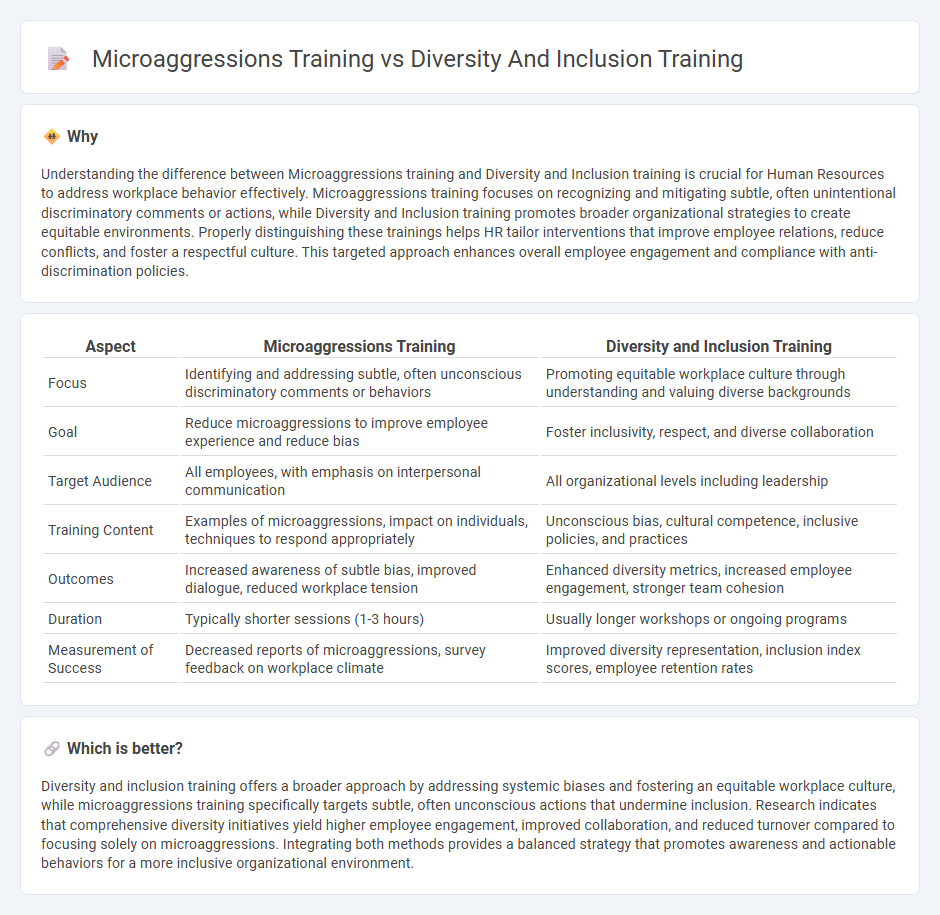
Microaggressions training focuses on identifying and addressing subtle, often unintentional discriminatory behaviors that impact workplace dynamics and employee well-being. Diversity and inclusion training emphasizes fostering a culture that values varied backgrounds and perspectives to enhance collaboration and innovation. Explore more to understand how each training modality can transform organizational culture effectively.
Why it is important
Understanding the difference between Microaggressions training and Diversity and Inclusion training is crucial for Human Resources to address workplace behavior effectively. Microaggressions training focuses on recognizing and mitigating subtle, often unintentional discriminatory comments or actions, while Diversity and Inclusion training promotes broader organizational strategies to create equitable environments. Properly distinguishing these trainings helps HR tailor interventions that improve employee relations, reduce conflicts, and foster a respectful culture. This targeted approach enhances overall employee engagement and compliance with anti-discrimination policies.
Comparison Table
| Aspect | Microaggressions Training | Diversity and Inclusion Training |
|---|---|---|
| Focus | Identifying and addressing subtle, often unconscious discriminatory comments or behaviors | Promoting equitable workplace culture through understanding and valuing diverse backgrounds |
| Goal | Reduce microaggressions to improve employee experience and reduce bias | Foster inclusivity, respect, and diverse collaboration |
| Target Audience | All employees, with emphasis on interpersonal communication | All organizational levels including leadership |
| Training Content | Examples of microaggressions, impact on individuals, techniques to respond appropriately | Unconscious bias, cultural competence, inclusive policies, and practices |
| Outcomes | Increased awareness of subtle bias, improved dialogue, reduced workplace tension | Enhanced diversity metrics, increased employee engagement, stronger team cohesion |
| Duration | Typically shorter sessions (1-3 hours) | Usually longer workshops or ongoing programs |
| Measurement of Success | Decreased reports of microaggressions, survey feedback on workplace climate | Improved diversity representation, inclusion index scores, employee retention rates |
Which is better?
Diversity and inclusion training offers a broader approach by addressing systemic biases and fostering an equitable workplace culture, while microaggressions training specifically targets subtle, often unconscious actions that undermine inclusion. Research indicates that comprehensive diversity initiatives yield higher employee engagement, improved collaboration, and reduced turnover compared to focusing solely on microaggressions. Integrating both methods provides a balanced strategy that promotes awareness and actionable behaviors for a more inclusive organizational environment.
Connection
Microaggressions training addresses subtle, often unintentional discriminatory behaviors that impact workplace culture, while Diversity and Inclusion training fosters awareness and respect for diverse backgrounds and perspectives. Both training programs are essential for creating psychologically safe environments where employees feel valued and understood. Integrating these trainings enhances organizational equity by reducing bias and promoting inclusive communication practices.
Key Terms
**Diversity and inclusion training:**
Diversity and inclusion training emphasizes fostering awareness, understanding, and respect for differences in race, gender, ethnicity, and other identities in the workplace, promoting a culture of equity and belonging. Microaggressions training specifically targets recognizing and addressing subtle, often unintentional discriminatory comments or behaviors that perpetuate bias. Explore how comprehensive diversity and inclusion programs can transform organizational culture and enhance employee engagement.
Unconscious Bias
Diversity and inclusion training addresses broader workplace culture by promoting acceptance and equal opportunity, while microaggressions training zeroes in on identifying and reducing subtle, often unconscious discriminatory behaviors. Both types of training emphasize the impact of unconscious bias, which influences decision-making and interpersonal interactions without conscious awareness. Explore how targeted unconscious bias interventions can enhance your organizational inclusivity initiatives.
Cultural Competence
Diversity and inclusion training emphasizes broad cultural competence by fostering awareness, respect, and collaboration among diverse groups, while microaggressions training targets specific behaviors and subtle biases that undermine inclusivity. Both approaches are critical for creating equitable workplaces but differ in scope: cultural competence develops overall intercultural understanding, whereas microaggressions training hones in on recognizing and mitigating everyday discriminatory acts. Explore our detailed resources to deepen your knowledge on these complementary strategies for enhancing cultural competence.
Source and External Links
Diversity & Inclusion in the Workplace Training - Online DEI Training - This 60-minute online course helps employees recognize bias, stereotypes, and discrimination, and provides strategies to foster a more inclusive and culturally aware workplace.
5 Types of Diversity Training in the Workplace - Diversity training consists of awareness building, skill development, and behavioral change to create a positive, equitable environment where employees can work together effectively despite their differences.
Diversity, Equity, Inclusion (DEI) Training - A 1-hour online course with certification, focusing on cultivating inclusivity, challenging biases, and enhancing cultural competence to promote a safer, more equitable workplace.
 dowidth.com
dowidth.com